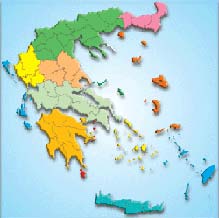
Please click on the map,
the region you want to visit |
|
|
|
|
| |
|
 |
Tourist Guide of Hydra |
|
With rich naval legacy, cosmopolitan
character Hydra attracts a lot of Greek and foreigner
visitors from each point of the globe.
It is an island where some of the important people
of the Greek revolution and public life came from.
Model of architecture and aesthetics constitutes
the city of Hydra with the graphic back streets
and the mansions, built amphitheatrically around
the harbour.
 Hydra,
is an island of the Northern Myrtoou Seas, that
are found in small distance by the south-eastern
coasts of Argolida, westwards from the entry of
Saronic Gulf. Hydra,
is an island of the Northern Myrtoou Seas, that
are found in small distance by the south-eastern
coasts of Argolida, westwards from the entry of
Saronic Gulf.
Hydra is a historical island, acquaintance from
the naval fight at the Turks, in the revolution
of 1821. In the modern times it constitutes one
of the most developed tourist islands of the Mediterranean,
with an intense cosmopolitan character. It has an
elongated form, with address Δ.ΝΔ.- Α.ΒΑ length
18 kilometres and biggest width 5. It's extent reaches
the 49,6 square kilometres and length of the coasts
about 56 kilometres.
'Hydra is a rocky mountainous island with low vegetation,
while you can find a few small pine forests. Characteristic
is also the lack of water, which is transported
with water wagon ship from the land of Peloponnese.
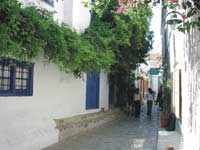
Higher tops of island are the Klimakio (or 'Love),
with altitude of 590, at the centre of the island,
and Gerakina, with altitude of 346, at the south-western
point.
The coasts of Hydra are mostly abrupt and rocky,
with rich horizontal and vertical territorial dismemberment.
You can find very few small sandy beaches. At the
western utmost the island is the cape Mpisti, in
the north-western coasts the bights of Saint Nikolaos
and Molos, while in the northern the bight of Hydra,
in mycho which is built the homonym town of, and
the bight Mandraki.
In the north-eastern department of the island there
is the cape Kastevas, the bight Ledeza, the capes
Mpretista and Maiati and the bight of Zodochos pigi
that leads at the south-eastern utmost of the island,
where is found the cape Zoyrbas or Zoyrba, while
in south-eastern you can find the bight Zoo, the
bight Avlaki, the Cape Mavri Myti, the bight Limioniza,
the capes Tsigkari and Saint Petros, the bight and
the cape Riga. Finally, in the southerners takes
shape the Cape of Saint Ioannis and in the south-western
point the Cape of Saint Konstantinos
Westwards Hydra is found the island Dokos from which
it is separated with the Narrow Petasi.
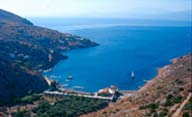 Between
Hydra and Dokos exist the islands Petasi and Pontikos
or Pontikonisi. In the north-western side of the
island, near the bight of Molos, is found the island
Kivotos and at the Eastern the islands Palamida
and Kamini. Southern of Hydra are found the islands
Tsigkri, Alexandros (or Platonisi), Ventza, Karteli,
Disakia and a bit further the islands Stroggylo,
Plateia, Drapio and Trikeri. Between
Hydra and Dokos exist the islands Petasi and Pontikos
or Pontikonisi. In the north-western side of the
island, near the bight of Molos, is found the island
Kivotos and at the Eastern the islands Palamida
and Kamini. Southern of Hydra are found the islands
Tsigkri, Alexandros (or Platonisi), Ventza, Karteli,
Disakia and a bit further the islands Stroggylo,
Plateia, Drapio and Trikeri.
The climate of Hydra is dry Mediterranean, with
extended summer and soft winter, at the duration
of which the temperature very infrequent approaches
0° C, while the phenomenon of snowfall is almost
unknown. The very little rains are marked from November
up to the dues of March. The dry climate, however,
constitutes one of the basic factors for the big
tourist movement that presents the island.
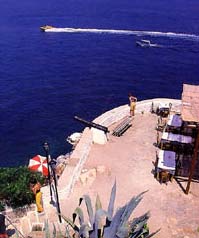 Unique
town on the island is Hydra. At the rest of the
island there are only small settlements, as e.g.
Blychos in western, the Episkopi at the south-west
and Mandraki at East. In the interior of island
exist, however, enough monasteries, as they are
Saint Efpraxias, the Prophet Ilia, Saint Matroni,
Saint Nikolaos, the Saint Trinity and the Birth
of Virgin Mary. Unique
town on the island is Hydra. At the rest of the
island there are only small settlements, as e.g.
Blychos in western, the Episkopi at the south-west
and Mandraki at East. In the interior of island
exist, however, enough monasteries, as they are
Saint Efpraxias, the Prophet Ilia, Saint Matroni,
Saint Nikolaos, the Saint Trinity and the Birth
of Virgin Mary.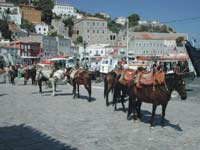
The tourist life of island assembles the town of
'Hydra. The island has rich naval history and the
shipping with the trade was the traditional occupation
of its very few residents, before the tourism overshadows,
mainly in the past few years, each other economic
activity. Characteristic is that the entire of the
island has been declared preservable and are prohibited.
In the municipality also belongs the settlements
Blychos, Episkopi, Mandraki, Abbey of Saint Efpraxias,
Abbey of Saint Trinity, Abbey of Saint Nikolaos,
Abbey of Birth of Virgin Mary Zoyrbas, Abbey of
Prophet Ilia, Molos, Palamidas and the islands Saint
Ioannis, Saint Nikolaos, Dokos, Platonisi, Stavronisi
and Trikeri.
The town of 'Hydra is built on two low rocky hills,
at the north-central department of island, in mycho
the homonym bight, with altitude 20. There is found
also the only harbour of the island.
Hydra is particularly graphic and maintains up to
today the traditional architecture. There are many
imposing mansions with traditional roofs, small
courtyards and peculiar internal decoration, with
small pavements with slabs alley.
The town has rich naval history. Today, however,
it is almost exclusively a big tourist centre that
assembles crowd of visitors at the summer months.
It allocates enough hotels and rented rooms, that
do not always suffice for the needs of the tourist
period, as well as restaurants, confectioneries
and centres of amusement. At it's very small port
there are small and big ships of recreation and
cruise ships. As you can imagine most of the residents
deal with the professions that have a relation to
the tourism. |
| HYDRA
Distinguished Glorious and Cosmopolitan |

The city that is the centre for the whole of the
island, is built amphitheatrically, round the harbour.
It strikes like a paint, with grey, white and blue
colours above light blue sea, model of architecture
and aesthetics.
Right and left in the entry of the harbour are found
the rampants with the hot rods, that protected the
city.
In the left side of the harbour, after the statue
of A. Miaoyli, is found the Port authority, that
is accommodated in the old, stone-built gunpowder
storehouse.
|
 |
Above: The emblem of Hydra.
Left, the left entry
the harbour. Are distinguished the rampant
with the hot rods, that protected the city
and under the statues of A. Miaoyli
|
|
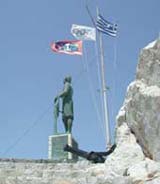 |
Beside it, is found the made of
marble building of files of Hydra and it follows
the house of family Tsamadou, where is accommodated
the famous Faculty of Merchant ship's captains.
The street leads to the gym and to the pine region
of abbey Saint Foteinis.
The street that begins from the means of harbour,
leads to the Kala Pigadia. If you keep walking you
will end up at the abbey of Prof. Ilia (1815) and
the abbey of Saint Efpraxias (1821).
In the centre of harbour is found the cathedral
temple, that was built in 1648 and reconstructed
in 1774.
In the old days it functioned as abbey of Kimiseos
of Virgin Mary. Today, in the abbey, is located
the Town hall and the ecclesiastical museum. Righter
the abbey of Kimiseos of Virgin Mary, begins a narrow,
paved with slabs, uphill street, that leads to the
old city, Kiafa.
The street passes from the Nursing home and leads
to Blycho.
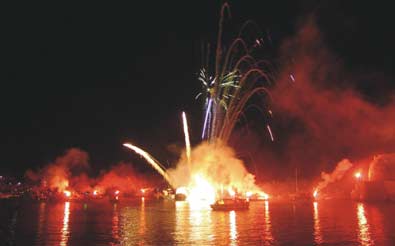 In
the right side of the harbour, the coastal street
passes under the mansion of Kountouriotis, the Mills
reaches in the Firing kiln and leads to Blycho. In
the right side of the harbour, the coastal street
passes under the mansion of Kountouriotis, the Mills
reaches in the Firing kiln and leads to Blycho.
Main characteristic element of Hydra is that you
cannot meet anything wheeled and the transportation
can only be with donkeys fact that makes hit even
more graphic. The harbour of Hydra is submerged
daily by small and big yachts, boats and cruise
ship.
In the island you will enjoy romantic walks in narrow,
graphic, pavements with slabs back street. In general
Hydra is famous for the calm life that offers during
the day, but also for the intense, cosmopolitan
life, the night. Bar, pub, disco, with foreigner-Greek
music and spree up to the morning.
With it's continuous offer in the tourism and the
cultural life of our country, remains peace of art
for the Argosaroniko and one of the more important
resorts in Greece.
|
|
|